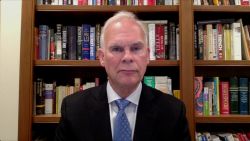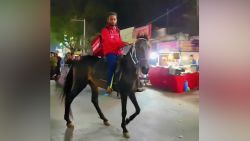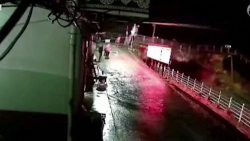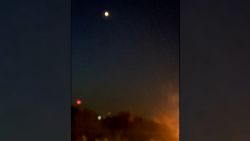Throughout history, protesters worldwide have torn down statues of dictators. In Hong Kong, they targeted lamp posts.
Two weeks ago, a band of masked protesters dramatically toppled one “smart” sensor-packed lamp post and damaged 19 others – not in retribution for past oppression, but for fear that it might spy on them in the future.
Dystopian uses of “smart” technology are a growing concern in cities around the world. But privacy and anonymity are particular obsessions this summer in Hong Kong. Facial masks have become the uniform of pro-democracy protesters who have swarmed the streets each weekend since June, and police conceal their faces behind shields and mirrored visors.
First sparked by anger over a bill that would allow suspected criminals to be extradited to China, the ongoing protests are now fueled by deepening suspicion of Hong Kong’s leaders, whom activists accuse of corroding the semi-autonomous city’s freedoms under pressure from Beijing.
And the more Hong Kong officials do to quiet the city’s unrest, the more their methods are scrutinized by citizens for any whiff of the mainland’s surveillance-first approach to law and order.

“White Terror”
When asked why they hide their identities, Hong Kong’s protesters often refer to something called “white terror.”
Over the last century, the historic term was used in Asia to describe bloody mass purges in revolutionary China and a period of suppression and martial law on the island of Taiwan. It is now an umbrella concept in Hong Kong – used by both Hong Kong Chief Executive Carrie Lam and pro-democracy youth activist Agnes Chow – for extralegal intimidation tactics, from police brutality to online harassment.
At an August 28 rally for airline workers who had been allegedly fired for expressing their political views – itself considered a form of white terror – a gray-haired protester told me on condition of anonymity that she was there because she didn’t want white terror anywhere in the world. Asked to explain the term, she said, “You will feel it when you post something on Facebook and think you could be accused of being a terrorist,” she said.
She wore her strawberry-print bandana across her nose and mouth, she explained, because she didn’t know if there were unfriendly cameras in the area. If a photo of her was posted online or given to mainland authorities, she said, “Maybe there will be some fighting, or effort to check your background, or some shouting at you, or some difficulty when you cross the border to China.” She said that she was sure her employer, a construction contractor, would fire her if she was identified as a protester.
After several hours under the afternoon sun, the audience suddenly erupted around one elderly man in the front row. Interrupting the speakers onstage, they accused him being a spy tasked with taking photos for Chinese authorities, which he denied.
As dozens pressed around him, his knees buckled and he was half-dragged to a low wall nearby. Teenagers, senior citizens and everyone in between shouted at him, forcing him to delete the pictures he had taken. “I want them for my memories,” he repeated weakly, making eye contact with no one. Only that evening did the protesters eventually let him wander off, grudgingly satisfied that he had deleted any pictures that could be used to identify their faces.
While rumors circulate that mainland officials are building a photo database of known protesters, there are already online efforts to crowdsource the names of both protesters and police. On encrypted app Telegram, channels dedicated to exposing personal information of people on both sides of the protest front lines have attracted tens of thousands of users.
Senior police officials, speaking on condition of anonymity, said officers’ personal data, contact information, home addresses and more had been shared online, and described being doxxed as a form of “psychological war.”
Feeling watched
There are already tens of thousands of mechanical eyes watching and recording streets and buildings in Hong Kong, but most public surveillance cameras aren’t designed to identify people. And while any high-quality camera can feed images into a database that might eventually be used to identify people, Hong Kong’s privacy ordinance instructs operators to delete footage as soon as possible.
That “smart” lamp post that was torn down by protesters on August 24 is one of 50 installed around the city, the first of 400 planned. Intended to collect data on traffic, weather and pollution, they’re packed with WiFi and Bluetooth connectivity, sensors and cameras. They also have visual analysis and tracking capabilities, however, those functions have never been activated, according to Nicholas Yang, the city’s secretary for innovation and technology. He says it’s simple “misunderstanding,” that the lamp posts might do “unwanted surveillance.”
Clearly frustrated with protesters’ criticisms, Yang tells CNN that the lamp posts fully comply with Hong Kong’s privacy laws, and that data generated by the posts is analyzed, anonymized and posted publicly, with any raw data instantly deleted. His bureau has also instituted advisory committees to vet the project as it develops.
But protesters already on watch for Beijing’s shadow are skeptical of officials’ reassurances about what the lamp posts do, or might do in the future.
“Can the Hong Kong government ensure that they will never install facial recognition tactics into the smart lamp post?” asks Joshua Wong, the 22-year-old Umbrella movement leader and prominent pro-democracy activist. “They can’t promise it and they won’t because of the pressure from Beijing.”
Shortly after the lamp post fell, a government contractor supplying Bluetooth beacons for the posts abruptly withdrew from the project, citing concern about attempts to intimidate employees’ families.
“We find it not acceptable and deeply regret that a local small enterprise has been doxxed and attacked because of its participation in the smart lampposts project. The incident is a serious blow to the hard work of the local innovation and technology industry,” a government spokesman said.
Smart cities
Cities around the world are experimenting with public monitoring and identification technologies, forcing residents to decide how much they want their governments to know about them in exchange for data-driven security, sanitation and efficiency.
In the cities of Singapore and Atlanta, there are now about 15 cameras for every 1,000 people, according to an August study by consumer technology website Comparitech. In London, there are 70 for every 1,000 people. But nowhere are the cameras proliferating faster than in China, which embraces automated mass surveillance and boasts of the achievements of its real-time facial recognition algorithms.
Eight of the top 10 most surveilled cities in the world are in China (based on ratio of cameras to people), and the government also has broad powers to examine data that traverses mainland infrastructure. In the closely-watched far-western region of Xinjiang, Beijing has used cameras, personal information and even “home stays” by party officials to monitor and detain members of the Muslim-majority Uyghur population.
“People are strongly aware that Hong Kong in the worst scenario could be the next Xinjiang,” Wong said.
He also cited fears of a less extreme scenario: the extension of China’s nascent national social credit system to Hong Kong. The system seeks to grade citizens based on their behavior, for example, punishing some for frivolous spending and rewarding others who follow the rules.
While there’s no sign that either scenario is in the cards for Hong Kong, both are indicative of what Hong Kongers fear – a shift away from rule of law and the use of dragnet surveillance not just to catch people mid-crime, but to root out undesirable actions, relationships and ideas, even if they’re legal on paper.
Hong Kong’s independent legal system includes a robust privacy ordinance on use of data and CCTV cameras. However, as in many countries, the right to privacy crumbles before state security; the ordinance allows personal data to be transferred without the consent of the individual in cases of crime or warrant-authorized surveillance.
Furthermore, laws can always be changed, as points out Stuart Hargreaves, associate law professor at the Chinese University of Hong Kong.
“The government could always abandon the law entirely, subject to the obligations it is under, thanks to the Basic Law (which does include a right to privacy), or it could amend the law to say that imagery gathered for public security is not subject to the retention elements of the law,” he said. But for now, he adds, “there’s no evidence they plan to do this.”
He emphasizes there is also no evidence that the government’s new lamp posts are a cover for increased surveillance.
“The fears of the smart posts are a proxy for fears about the deteriorating status of civil liberties in Hong Kong generally, rather than because of evidence that the government has used CCTV cameras in a particularly nefarious way,” Hargreaves said.
Hong Kong’s leader, Carrie Lam, had hoped to take the wind out of the months-long movement last week by finally announcing the formal withdrawal of the controversial extradition bill.
But the movement has since moved on to bigger concerns. Last weekend, tens of thousands of protesters filled the city’s central streets, most of their faces covered as they marched to the US Consulate to ask for sanctions on members of their own government.
For now, they seem to see little reason to give up their masks.



























